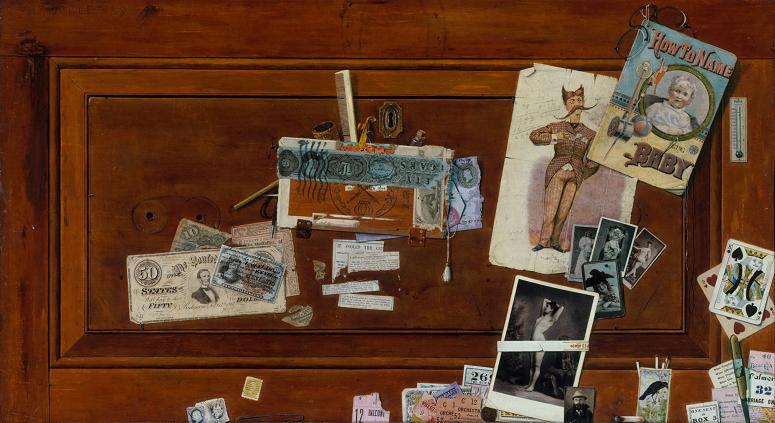
John Haberle. John Haberle was an American painter in the trompe-l'oeil style.
His still lifes of ordinary objects are painted in such a way that the painting can be mistaken for the objects themselves. He is considered one of the three major figures, together with William Harnett and John F. Peto, practicing this form of still life painting in the United States in the last quarter of the 19th century.
Haberle was born in 1856 in New Haven, Connecticut, and was the son of Swabian immigrants. At the age of 14 he left school to apprentice with an engraver.
He also worked for many years as an illustrator and exhibit preparator for the Peabody Museum of Natural History at Yale University, working under the supervision of the paleontologist Othniel Charles Marsh. Haberle began taking classes at the National Academy of Design in New York City in 1884, where he first encountered trompe-l'oeil painting.
Haberle's style is characterized by a meticulous rendering of two-dimensional objects. He is especially noted for his depictions of paper objects, including currency. Art historian Alfred Frankenstein has contrasted Haberle's work with that of his contemporaries: Peto is moved by the pathos of used-up things. Haberle is wry and wacky, full of bravado, self-congratulating virtuosity, and sly flamboyance. He works largely within an old tradition, that of the trompe-l'oeil still life in painted line. It
His still lifes of ordinary objects are painted in such a way that the painting can be mistaken for the objects themselves. He is considered one of the three major figures, together with William Harnett and John F. Peto, practicing this form of still life painting in the United States in the last quarter of the 19th century.
Haberle was born in 1856 in New Haven, Connecticut, and was the son of Swabian immigrants. At the age of 14 he left school to apprentice with an engraver.
He also worked for many years as an illustrator and exhibit preparator for the Peabody Museum of Natural History at Yale University, working under the supervision of the paleontologist Othniel Charles Marsh. Haberle began taking classes at the National Academy of Design in New York City in 1884, where he first encountered trompe-l'oeil painting.
Haberle's style is characterized by a meticulous rendering of two-dimensional objects. He is especially noted for his depictions of paper objects, including currency. Art historian Alfred Frankenstein has contrasted Haberle's work with that of his contemporaries: Peto is moved by the pathos of used-up things. Haberle is wry and wacky, full of bravado, self-congratulating virtuosity, and sly flamboyance. He works largely within an old tradition, that of the trompe-l'oeil still life in painted line. It
Wikipedia ...